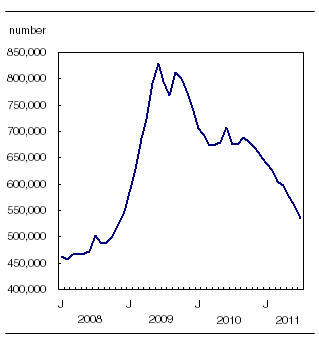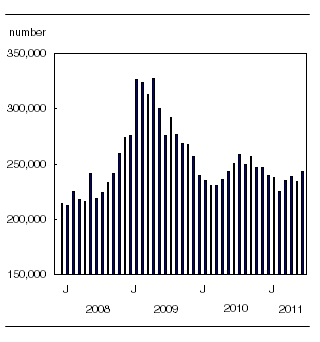Employment Insurance
Archived Content
Information identified as archived is provided for reference, research or recordkeeping purposes. It is not subject to the Government of Canada Web Standards and has not been altered or updated since it was archived. Please "contact us" to request a format other than those available.
Related subjects
-
[an error occurred while processing this directive]
The number of people receiving regular Employment Insurance (EI) benefits decreased by 24,800 (-4.4%) in July to 535,700, the largest of 10 consecutive monthly declines.
There were notable percentage decreases in all provinces except New Brunswick, where it was little changed, and Newfoundland and Labrador, where the number of beneficiaries was up slightly.
Downward trend in the number of Employment Insurance beneficiaries continues in July

More claims in July
To receive EI benefits, individuals must first submit a claim. The number of claims provides an indication of the number of people who could become beneficiaries.
While there were fewer people receiving benefits in July, the number of initial and renewal claims rose by 8,800 (+3.8%) to 243,300, the third increase in four months.
Note to readers
All data in this release are seasonally adjusted unless otherwise specified.
Each month, Statistics Canada provides analysis of the current labour market situation, using Employment Insurance (EI) statistics and other sources. Earlier this month, the Labour Force Survey (LFS) provided a picture of overall labour market conditions, including unemployment, total employment and characteristics of those affected by changes in the labour market.
In this release, Statistics Canada provides additional sub-provincial detail through the EI statistics. Details by industry will follow with data from the Survey of Employment, Payrolls and Hours.
EI statistics are produced from administrative data sources provided by Service Canada and Human Resources and Skills Development Canada. These statistics may, from time to time, be affected by changes to the Employment Insurance Act or administrative procedures. The number of regular beneficiaries and the number of claims received for June and July are preliminary. In this release, large centres correspond to those with a population of 10,000 or more.
The number of beneficiaries is a measure of all persons who received EI benefits from July 10 to 16. This period coincides with the reference week of the LFS.
EI statistics indicate the number of people who received EI benefits, and should not be confused with data coming from the LFS, which provides information on the total number of unemployed people.
There is always a certain proportion of unemployed people who do not qualify for benefits. Some unemployed people have not contributed to the program because they have not worked in the past 12 months or their employment is not insured. Other unemployed people have contributed to the program but do not meet the eligibility criteria, such as workers who left their job voluntarily or those who did not accumulate enough hours of work to receive benefits.
The change in the number of regular EI beneficiaries reflects various situations, including people becoming beneficiaries, people going back to work, and people exhausting their regular benefits.
Number of claims up in July

Chart description: Number of claims up in July
There were more claims in several provinces in July, with the highest percentage increase in Ontario (+19.0%). This increase follows a period of little change in the number of claims in Ontario since January. In Newfoundland and Labrador, the number of claims fell for the second consecutive month, down 10.0% in July.
Fewer beneficiaries in most provinces
There were fewer people receiving regular EI benefits in July, with the largest percentage decrease occurring in Manitoba, down 9.1% to 11,700.
The number of beneficiaries also fell in Quebec (-5.8%), Ontario (-5.7%), Alberta (-5.4%), Saskatchewan (-5.3%), Nova Scotia (-5.2%) and British Columbia (-4.2%). The declines in July extend the downward trends in these provinces that began in the fall of 2010.
Newfoundland and Labrador (+1.2%), which was the lone province where there were more beneficiaries in July, posted a second consecutive increase.
Sub-provincial and demographic overview
EI data by sub-provincial region, sex and age are not seasonally adjusted and are therefore compared on a year-over-year basis.
Most large centres show year-over-year declines
Between July 2010 and July 2011, the number of people receiving regular benefits at the national level fell by 147,000 (-22.3%). Declines occurred in nearly all 143 large centres (see map). Large centres are those with a population of 10,000 or more.
In Newfoundland and Labrador, there were fewer beneficiaries in four of the five large centres. The largest percentage decline occurred in St. John's (-16.3%), extending the trend of monthly year-over-year decreases that began in April 2010. There were also notable percentage declines in the 12 months to July in Grand Falls-Windsor and Corner Brook.
All large centres in Nova Scotia had fewer beneficiaries in July compared with July 2010. The most notable percentage decline was in Halifax, where the number fell by 17.9% to 5,200 people.
In New Brunswick, five of the six large centres had fewer beneficiaries in the 12 months to July, with the fastest pace of decline in Moncton (-11.5%) and Saint John (-8.6%).
The number of regular beneficiaries fell in 31 of the 33 large centres in Quebec. The fastest pace of decline occurred in the census metropolitan area of Québec, where the number of beneficiaries was down 30.0% to 8,100. In Montréal, there were 25.2% fewer beneficiaries, continuing the trend of year-over-year monthly declines that began in March 2010. There were also notable declines in Sherbrooke, Saint-Hyacinthe, Magog, Granby, Saint-Jean-sur-Richelieu and Victoriaville.
All large centres in Ontario had year-over-year declines in the number of beneficiaries, with the largest percentage decrease occurring in Greater Sudbury. In Toronto, the number fell by 26.9% to 64,100, extending the trend of year-over-year declines that began in March 2010. Other large centres with marked percentage decreases in July include Thunder Bay, Tillsonburg, Guelph, Port Hope, Chatham-Kent and North Bay.
In Manitoba, the number of people receiving regular benefits fell in all four large centres in the 12 months to July. In Winnipeg, the number of beneficiaries declined by 32.5% to 6,000, the largest of 11 consecutive decreases.
In Saskatchewan, there were year-over-year declines in all eight large centres. The fastest pace of decline occurred in Regina, where the number of beneficiaries was down 41.7% to 1,100, prolonging the trend of monthly year-over-year decreases which started in July 2010. In Saskatoon, the number of beneficiaries fell by 35.0% to 2,000, the largest of eight consecutive declines.
In Alberta, all 12 large centres had fewer beneficiaries compared with July 2010. In Calgary, the number fell 36.4% to 9,700. At the same time, it fell in Edmonton by 35.5% to 9,900. Other large centres with notable year-over-year declines include Red Deer, Cold Lake, Grande Prairie and Medicine Hat.
The number of beneficiaries fell in all 25 large centres of British Columbia. The number fell by 32.8% in Vancouver and by 23.1% in Victoria. Prince Rupert, Campbell River, Kamloops, Powell River and Terrace were also among those large centres with marked percentage declines.
Demographic groups
In July, the number of men receiving regular benefits fell 22.5% from 12 months earlier to 272,100. There were declines of 24.6% for men aged 25 to 54 and 23.6% for those under 25 years of age. The number of male beneficiaries aged 55 and over also fell in the 12 months to July, down 15.2%.
During this year-long period, the percentage decline for women was similar to that for men. The number of women receiving benefits fell by 22.1% to 239,500. It decreased by 23.4% for women aged 25 to 54 and by 22.6% for those under 25. The decline for women 55 and over was 17.0%, the largest of five consecutive decreases for this group.
Available on CANSIM: tables 276-0001 to 276-0006, 276-0009, 276-0011, 276-0015 and 276-0016.
Definitions, data sources and methods: survey number 2604.
Data tables are also now available online. From the Key resource module of our website under Summary tables, choose Subject then Labour.
Data on Employment Insurance for August will be released on October 20.
A set of maps, Employment Insurance Statistics Maps, July 2011 (73-002-X, free), is now available online. The maps show percent changes in the number of people receiving regular EI benefits for all census metropolitan areas and census agglomerations in Canada. From the Key resource module of our website, under Publications, choose All subjects, then Labour.
For more information, or to order data, contact Client Services (toll-free 1-866-873-8788; 613-951-4090; labour@statcan.gc.ca). To enquire about the concepts, methods or data quality of this release, contact Vincent Ferrao (613-951-4750), Labour Statistics Division.
- Date modified:
